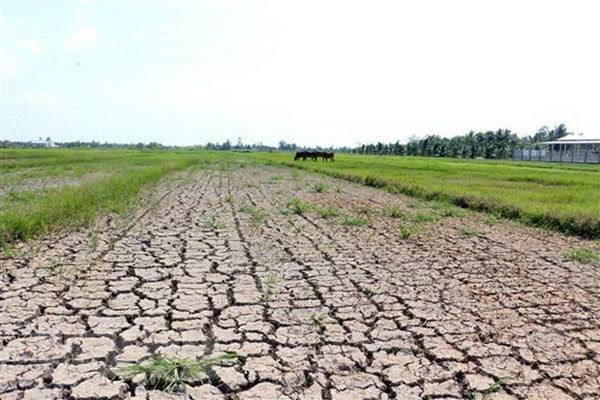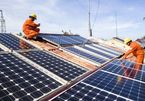 |
| Drought in the Mekong Delta province of Ben Tre. VNA/VNS Photo |
Will you please tell us how has the national plan on climate change response been implemented so far?
The Resolution No 24 of the Vietnam Party Central Committee which was released on June 3, 2013 emphasises that the fight against natural calamity, particularly in the context of climate change, must be embedded in all Government policies, strategies and plans toward the goal of sustainable development and the use of the country’s natural resources while protecting the environment.
The national plan for the period from 2021-30 and the vision towards 2050 has come up with specific objectives: to minimise the vulnerabilities and risks from the climate change impacts on the community, all economic entities while promoting the integration of climate change adaptability into the national strategy and plans.
Can you give us some most important missions that will be carried out in the next few years?
There are three groups of important missions and tasks that must be carried out in the course of implementing the Government Resolution No 93 which is in line with Paris Agreement on the climate change. They are as follows:
First, to improve the adaptability of climate change into the national strategy and plans with specific missions and solutions. In particular, we need to focus on reviewing, updating and building new socio-economic development plans on the basis of climate change scenarios and assessment of climate change impacts; monitoring and evaluating these plans to improve the effectiveness of climate change adaptation; periodically updating climate change scenarios; establishing a national database and support tools for climate change policy management and planning. It's also important to work on mobilising and distributing financial resources for the task.
Second, to strengthen the probability and adaptability of the whole community, including different economic sectors and the country’s ecosystem through the investment in adaptation actions, science and technology, and awareness raising activities.
Third, to develop specific plans and measures to minimise the impacts of the climate change. This will include improving monitoring capacity on climate change and hydro-meteorological forecasting; communicating information about natural disasters and climate extremes; ensuring the safety of irrigation works; improving the natural disaster risk management system; focusing on community-based disaster management solutions; promoting local knowledge in disaster prevention; and dealing with post-disaster damages.
How will the national plan on climate change adaptability be implemented in the 10 years from 2021-30 and the vision by 2050?
Measures and solutions are divided each five year plan (from 2021-25; 2026-30) and the vision by 2050.
In the 2021-25 period, Vietnam will focus on further completion of the policies on climate changes and then reflect these policies in the national strategy to respond to the natural calamity.
In the 2026-25 period with lessons learned from the previous five years, Vietnam will make adjustments to improve the capacity of industries, sectors, communities and ecosystems to increase their resilience to climate change and the readiness to adapt to changes in climate. We will also work to improve the resilience of infrastructure systems, the ecosystems and biodiversity; and protect and conserve biodiversity from climate change impacts. Promoting adaptation actions that bring benefits in mitigating risks caused by climate change and efficiency in terms of economy, society and environment is also encouraged.
In the period after 2030 to 2050, Vietnam will promote the results achieved in the 2021-30 period, further strengthening human capacity to adapt to climate change, infrastructure and natural systems. This aims at protecting and improving quality of life, ensuring food security, energy security, water security for a sustainable development in the context of climate change.
Mobilising resources is important for the implementation of climate change adaptation activities. How will relevant agencies mobilise resources to implement the plan?
Resources for the implementation of the plan are mobilised from different channels, complying with relevant laws and legal provisions. Sources of finance for adaptation activities can be mobilised from the State budget (including central and local budgets); international support; resources of businesses and community contributions.
In particular, the State annually allocates funds from the central budget, local budgets and international support resources to implement, especially for the tasks of perfecting adaptive mechanisms and policies relating to climate change and implementing urgent investment projects. Resources for climate change adaptation tasks should be incorporated into strategic plans, programmes and projects of ministries, sectors and localities.
There are a number of multilateral cooperation channels to support climate change adaptation actions that can be accessed, including the Global Environment Fund, the Adaptation Fund, which was established under the Kyoto Protocol of the UN Framework Convention on Climate Change, providing financial sources to climate adaptation and resilience activities; the Green Climate Fund which supports projects, programmes, policies and other activities on climate change adaptation and greenhouse gas emission reduction for developing countries.
Vietnam can also access technical assistance provided by development banks and UN organisations on climate change, as well as support from non-governmental organisations for climate change adaptation at local level. At the same time, the State creates a legal basis and market tools to encourage and facilitate financial institutions, domestic and foreign enterprises to invest and support the implementation of the plan. VNS/VGP

Vietnamese Government plan aims to improve adaptation to climate change
Enhancing State management of climate change is one of the major measures in the national plan on climate change adaptation for 2021-2030, with a vision towards 2050, recently issued by Prime Minister Nguyen Xuan Phuc.

Hanoi strives to reduce greenhouse gas emissions by 12% by 2025
The Hanoi People's Committee has set targets for reducing greenhouse gas emissions in the city.
 Head of the Ministry of Natural Resources and Environment's Climate Change Department Tang The Cuong talks about the national plan on climate change adaptation for 2021-30, with a vision towards 2050.
Head of the Ministry of Natural Resources and Environment's Climate Change Department Tang The Cuong talks about the national plan on climate change adaptation for 2021-30, with a vision towards 2050.